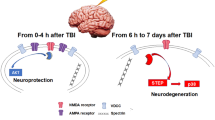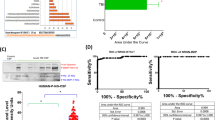Abstract
A number of brain insults including traumatic brain injury (TBI) can result in excitotoxic consequences largely attributable to pathological increases in intracellular calcium (1,2). Loss of calcium homeostasis can result in activation of the calcium-dependent proteases, or calpains, that may be one of the principle causes of pathology after acute central nervous system (CNS) injury (3). A zymographic assay for calpains using nondenaturing casein-containing polyacrylamide gels was originally developed for in vitro studies (4). Recently, we have refined this approach to apply to in vivo studies of acute CNS injury (5,6). This technique allows for differential and concurrent measurement of the two major isoforms of calpain, m-calpain and μ-calpain. This technique also provides the opportunity for analyzing protease activity in cytosolic and total membrane fractions (with appropriate sample preparation), an important consideration because calpain translocation may be a determinant of its attack on membrane-bound cytoskeletal protein targets (7). The zymographic assay also assesses calpain activity independently of the effects of the endogenous calpain inhibitor, calpastatin. Acute CNS injury such as TBI can also importantly affect brain pH, and both μ-calpain and m-calpain in brain are sensitive to changes in pH (8,9).
Access this chapter
Tax calculation will be finalised at checkout
Purchases are for personal use only
Similar content being viewed by others
References
Fineman I., Hovda D. A., Smith M., Yoshino A., and Becker D. P. (1993) Concussive brain injury is associated with a prolonged accumulation of calcium: A 45Ca autoradiographic study. Brain Res. 624, 94–102.
Nilsson P., Hillered L., Olsson Y., Sheardown M. J., and Hansen A. J. (1993) Regional changes in interstitial K+ and Ca2+ levels following cortical compression contusion trauma in rats. J. Cereb. Blood Flow Metab. 13, 183–192.
Kampfl A., Posmantur R. M., Zhao X., Schmutzhard E., Clifton G. L., and Hayes R. L. (1997) Mechanisms of calpain proteolysis following traumatic brain injury: Implications for pathology and therapy: A review and update. J. Neurotrauma 14, 121–134.
Raser K. J., Posner A., and Wang K. K. W. (1995) Casein zymography: A method to study μ-calpain, m-calpain, and their inhibitory agents. Arch. Biochem. Biophys. 319, 211–216.
Zhao X., Newcomb J. K., Posmantur R. M., Wang K. K. W., Pike B. R., and Hayes R. L. (1998) pH dependence of μ-calpain and m-calpain activity assayed by casein zymography following traumatic brain injury in the rat. Neurosci. Lett. 247, 53–57.
Zhao X., Posmantur R., Kampfl A., Liu S. J., Wang K. K. W., Newcomb J. K., Pike B. R., Clifton G. L., and Hayes R. L. (1998) Subcellular localization and duration of μ-calpain and m-calpain activity following traumatic brain injury in the rat: A casein zymography study. J. Cereb. Blood Flow Metab. 18, 161–167.
Saido T. C., Sorimachi H., and Suzuki K. (1994) Calpain: new perspectives in molecular diversity and physiological-pathological involvement. FASEB J. 8, 814–822.
Chesler M. and Kaila K. (1992) Modulation of pH by neuronal activity. Trends Neurosci. 15, 396–402.
Nilsson E., Ostwald K., and Karlsson J. O. (1991) Changes in brain calpain activity as a result of in vitro ischemia and pH alterations. Mol. Chem. Neuropathol. 14, 99–111.
Author information
Authors and Affiliations
Editor information
Editors and Affiliations
Rights and permissions
Copyright information
© 2000 Humana Press Inc.
About this protocol
Cite this protocol
Zhao, X., Newcomb, J.K., Pike, B.R., Hayes, R.L. (2000). Casein Zymogram Assessment of μ-Calpain and m-Calpain Activity After Traumatic Brain Injury in the Rat In Vivo. In: Elce, J.S. (eds) Calpain Methods and Protocols. Methods in Molecular Biology™, vol 144. Humana Press. https://doi.org/10.1385/1-59259-050-0:117
Download citation
DOI: https://doi.org/10.1385/1-59259-050-0:117
Publisher Name: Humana Press
Print ISBN: 978-0-89603-632-1
Online ISBN: 978-1-59259-050-6
eBook Packages: Springer Protocols




